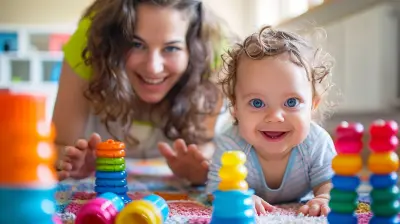Teaching Your Kids the Value of Work-Life Balance
13 June 2025
Let’s be real—life these days can feel like a constant juggling act. Between work, school, chores, errands, and the occasional effort to remember that self-care is still a thing, balance can seem like a mythical unicorn. But here's a thought—what if we could help our kids understand the beauty of balance before they’re drowning in adulthood responsibilities?
Teaching your kids the value of work-life balance isn’t just for the sake of calm Saturdays and fewer meltdowns. It's a real-life superpower that can boost their emotional intelligence, increase their self-awareness, and help them prioritize well-being all the way into adulthood.
So, how do you teach a kid (who still thinks bedtime is a punishment) about the balance between work and rest? That’s exactly what we’re diving into today.
Why Bother with Work-Life Balance at a Young Age?
Before we jump into the how, let’s talk about the why. Kids watch everything we do—yes, even when we think they're glued to their screens. They absorb our routines, our stress levels, and our habits like little sponges.When children grow up observing adults constantly stressed, skipping meals, and glued to laptops late into the night, guess what they start to believe? That’s just what adulting looks like. That’s the norm.
But what if we rewrote that script? What if our kids grew up seeing that success doesn’t have to mean burnout, and that being productive and rested is totally doable?
Planting the seeds of work-life balance early helps build:
- Healthy boundaries
- Strong time-management skills
- Emotional resilience
- A better sense of self-worth not tied to productivity
How Your Lifestyle Shapes Their Mindset
Kids may not always listen, but they’re always watching. One of the most powerful parenting hacks? Be the model.If you come home from work frazzled, immediately dive into answering emails, and skip dinner to take one last call, that leaves a lasting imprint.
But if your kids see you setting boundaries—logging off at a set time, enjoying weekend downtime, taking vacations without guilt—they start to believe that taking care of themselves is not just okay, it’s essential.
That doesn’t mean you have to be flawless. In fact, showing them that you’re trying to balance things can be even more impactful than pretending you’ve got it all together.
Try saying things like:
>”I had a tough day at work, so I’m going to take a walk to clear my head.”
or
>”I have a lot on my plate, but I’m setting limits so I have time for you and for myself.”
Let them see you pausing, resetting, and rebalancing. It’s not weakness—it’s wisdom.
Start with Age-Appropriate Conversations
You don’t have to sit your five-year-old down for a crash course in corporate burnout. Tailor your conversations based on their age and maturity level.For Younger Kids (Ages 4–8):
Use simple language and examples from their world. You could say:>“You know how you need breaks after playing for a long time so you don’t get tired or cranky? Grown-ups need breaks from work, too.”
Play-based lessons work wonders. Use toys, role play, or storybooks to highlight characters taking breaks, asking for help, or enjoying quiet time.
For Tweens (Ages 9–12):
This is a great age to introduce schedules and time-blocking. Teach them how to manage their homework and chores while leaving room for play and rest.You might say:
>“Let’s make a plan for your week. We’ll fit in homework, but also time for soccer, gaming, and just chilling. That way, you’re not doing everything at once and getting worn out.”
Use visual aids like calendars or planners—they love colorful stickers and pens, and it makes planning fun instead of a chore.
For Teens:
This is when things get real. School, social life, part-time jobs, and possibly college prep—it’s a lot. Help your teen look at their commitments and evaluate priorities.Ask them:
>“How are you feeling about your schedule this week? Do you need to shift anything around to feel more balanced?”
Teach them that it’s okay to say “no” and that mental health is just as important as physical health.
Let Them Experience Both Sides of the Coin
Balance is something best understood through experience. Let them handle responsibility and relaxation. It’s all about showing cause and effect.For example:
- Let them over-schedule once in a while. Then, when they feel overwhelmed, talk about how that felt. This opens the door for conversations about boundaries and limits.
- Celebrate their rest days like you would an accomplishment. Praise their choice to take a nap, read a book, or put their phone down for a break.
- Involve them in your own balancing acts. If you’re choosing to skip a meeting for a family dinner, tell them why that decision mattered.
These real-life moments help them build an internal compass for balance—far more than lectures ever could.
Create a Balanced Family Routine
Kids thrive on routines because they provide structure and safety. But routines don’t have to be rigid—they can flex with your family’s values and rhythms.Here are some ways to weave balance into your family’s weekly flow:
- Schedule family time like you would a meeting. Block out time for a movie night, a board game, or cooking together. When it’s on the calendar, it’s easier to make it happen.
- Build in downtime—not every moment has to be productive. Encourage “do nothing” afternoons or tech-free evenings.
- Create tech boundaries. Have one or two hours a day where everyone—yes, including you—puts away devices. This models intentional unwinding and presence.
- Designate “catch-up days”. Whether it’s for missed assignments or cleaning up a messy room, having a buffer built into the week eases pressure and teaches time management.
Encourage Passions Without Pressure
Let’s face it—today’s kids are often overscheduled with school, hobbies, tutoring, sports, and more. While it’s awesome to explore passions, it’s important that those passions bring joy, not just performance.Ask your child from time to time:
> “Are you still enjoying this activity? Or is it feeling like just another thing you have to do?”
If they say the joy is gone, it might be time to pivot. Help them feel safe making choices that protect their energy and well-being, even if it means dropping piano or dance.
The goal is to teach them that saying “yes” to themselves doesn’t mean letting others down.
Make Space for Emotional Check-Ins
Sometimes we don’t notice we’re out of balance until we’re already overwhelmed. Teaching your child to check in with themselves emotionally is a skill that will serve them for life.Here are some simple practices:
- Use a Feelings Chart to help younger kids name their emotions
- Encourage journaling for teens as a way to process stress
- Have weekly “How are you really?” talks as a family
- Play “High, Low, Buffalo” at dinner: share a high point, a low point, and something random or unexpected from the day
These check-ins won’t just help them spot stress—they’ll normalize asking for help when things feel off.
Teach That Productivity Doesn’t Equal Worth
Probably the most powerful message we can give our kids is this:>“You are valuable because of who you are, not what you do.”
In a world that often celebrates hustle above all else, this can be a game-changer. Help them see that rest, pleasure, and joy aren’t just rewards—they’re necessary ingredients for a full life.
Let them be bored. Let them play. Let them rest.
Because in those seemingly “unproductive” moments, they’re learning how to regulate themselves, how to enjoy stillness, and how to live a life that feels good—not just looks good on paper.
The Long-Term Payoff
You might be wondering—does any of this really matter in the long run?Absolutely.
Kids who grow up learning about work-life balance are more likely to:
- Have better coping skills
- Avoid burnout in school and in their future careers
- Set healthy boundaries in relationships
- Prioritize mental and physical health
- Develop strong time-management and planning habits
In short, you’re not just teaching them how to make a to-do list. You’re teaching them how to build a life—one where they have time to chase dreams and breathe.
Final Thoughts: It’s Not About Perfection
Let’s not pretend balance is easy. Some weeks might feel like chaos despite your best efforts. That’s okay.It’s not about being the perfect parent or raising perfect kids. It’s about showing them that being human means having needs, limits, and the power to say, “I need a break.”
When your kids see you pursuing balance—not flawlessly, but intentionally—they’ll learn that life isn’t a race. It’s a rhythm.
So go ahead, take that nap. Leave work on time. Say no to one more thing on the calendar.
Not just for you, but for them.
Because the best way to teach your child the value of work-life balance… is to live it.
all images in this post were generated using AI tools
Category:
Working MomsAuthor:

Liam Huffman
Discussion
rate this article
2 comments
Jenna Franklin
In the dance of days, let balance sway, Where work meets play in gentle array. Teach them to cherish both toil and rest, In harmony's embrace, they'll find their quest. With every moment, let them see, A life well-lived is truly free.
November 25, 2025 at 4:02 AM
Wren Harper
Work-life balance isn’t just a buzzword; it's a necessity. Teach your kids that hustle doesn’t equal success. Encourage them to prioritize mental health, relationships, and passions alongside ambition. A fulfilled life is built on balance, not burnout.
June 23, 2025 at 4:28 AM

Liam Huffman
Absolutely! Teaching kids the importance of work-life balance lays the foundation for a healthier, more fulfilling future. It's essential for their overall well-being and success.


